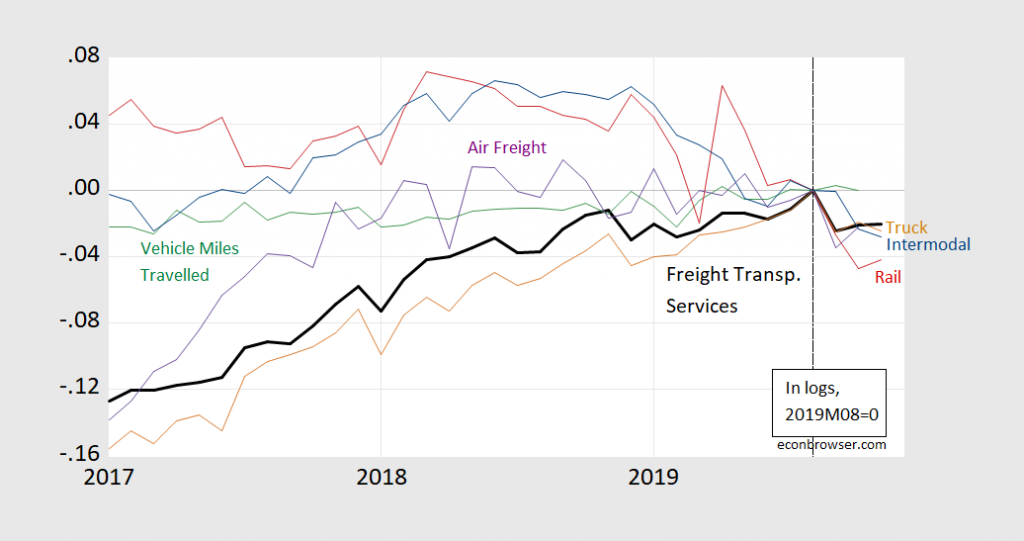Most accounts these days suggest the risk of recession has abated, given the strength of various indicators, and the un-inversion of the yield curve. This made me wonder what two key indicators look like in real time on the eve of a recession. Take a look at these two graphs, to see which one denotes data just before a recession.
Guest Contribution: “Carbon Prices, not Monetary Policies, Are the Tools to Fight Climate Change”
Today, we present a guest post written by Jeffrey Frankel, Harpel Professor at Harvard’s Kennedy School of Government, and formerly a member of the White House Council of Economic Advisers. A shorter version appeared in Project Syndicate January 17th.
Judy Shelton to the Fed?
From the White House:
A “Critique” of Confidence Intervals
Steven Kopits opines on statistics:
I don’t like confidence intervals for two reasons:
Planes, Trains, and Automobiles – and Trucks
Figure 1: Freight Transportation Services Index (bold black), Truck Tonnage Index (tan), Vehicle Miles Traveled (green), Rail Freight Carloads (red), Rail Freight Intermodal Traffic (blue), Air Revenue Ton Miles of Freight and Miles (purple), all in logs, 2019M08=0. Source: BTS via FRED, and author’s calculations.
All series are below peak.
David Romer: “In Praise of Confidence Intervals”
That’s the name of a new NBER working paper, and a paper presented at ASSA (slides; I didn’t get to see myself). As I get to teach applied econometrics for public policy this semester, I thought this was interesting paper. From the abstract:
Business Cycle Indicators as of Today
December industrial production (red line) adds to the (mixed) picture…
The US China Phase 1 Deal Interpreted: Break Thing, Claim to Fix Thing, Repeat
Through 2018M03, US exports to China were growing smartly. The Section 232 and Section 301 actions were announced. The “deal” essentially restores real exports to China to the pre-shock trend for 2020, above for 2021 (if you believe!).
GAO: “Office of Management and Budget—Withholding of Ukraine Security Assistance”
From GAO today on “the drug deal”:
In the summer of 2019, the Office of Management and Budget (OMB) withheld from obligation funds appropriated to the Department of Defense (DOD) for security assistance to Ukraine. In order to withhold the funds, OMB issued a series of nine apportionment schedules with footnotes that made all unobligated balances unavailable for obligation.
Faithful execution of the law does not permit the President to substitute his own policy priorities for those that Congress has enacted into law. OMB withheld funds for a policy reason, which is not permitted under the Impoundment Control Act (ICA). The withholding was not a programmatic delay. Therefore, we conclude that OMB violated the ICA.
EconoFact: “What is the Toll of Trade Wars on U.S. Agriculture?”
By Menzie Chinn and Bill Plumley, at EconoFact, posted a few minutes ago:
U.S. agriculture has been caught in the tit-for-tat of the trade wars. Retaliation by China, Canada, Mexico, Turkey and members of the European Union to tariffs imposed by the Trump administration have taken a bite out of U.S. agricultural incomes. Tariffs on imports of steel and aluminum in the United States have also raised costs for machines, equipment and structures used by the agriculture sector. Agriculture incomes would have shown no growth in 2019 but for massive and unprecedented federal assistance. Even with this assistance, however, the agriculture sector shows signs of stress, with a rise in debt, a decrease in solvency and an increased number of bankruptcies.
